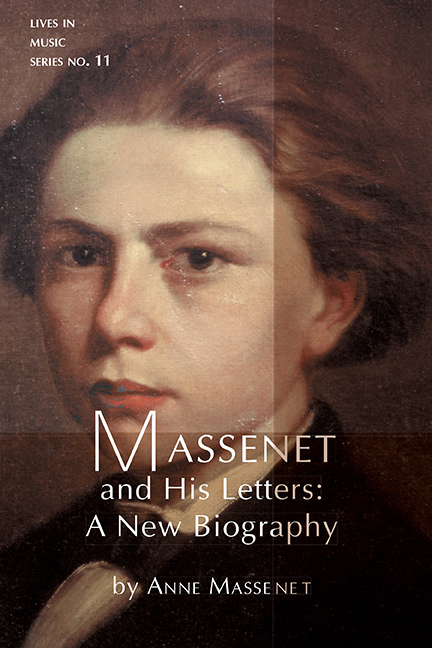Book contents
- Frontmatter
- Contents
- List of Illustrations
- Simplified Genealogy of the Massenet Family
- Foreword
- Dedication
- Translator's Preface
- I Years of Apprenticeship and Roman Adventure
- II The Steps of Quai Conti
- III Notebooks and Sketches
- IV Sybil Sanderson—“The Unique”
- V Massenet's Students
- VI Summer Solitude
- VII The Last Years—Posthumia
- VIII Conclusion
- Massenet: Biographical Chronology
- Bibliography
- About the Author
- Translator's Notes
- About the Translator
- General Index
- Index of Massenet's Works Cited
- Index of Letters Cited
IV - Sybil Sanderson—“The Unique”
- Frontmatter
- Contents
- List of Illustrations
- Simplified Genealogy of the Massenet Family
- Foreword
- Dedication
- Translator's Preface
- I Years of Apprenticeship and Roman Adventure
- II The Steps of Quai Conti
- III Notebooks and Sketches
- IV Sybil Sanderson—“The Unique”
- V Massenet's Students
- VI Summer Solitude
- VII The Last Years—Posthumia
- VIII Conclusion
- Massenet: Biographical Chronology
- Bibliography
- About the Author
- Translator's Notes
- About the Translator
- General Index
- Index of Massenet's Works Cited
- Index of Letters Cited
Summary
“The Opéra-Comique has been reduced to a pile of rubble!” opened a horrifying editorial on May 28, 1887, in Le Monde artiste,describing the first of two conflagrations darkening the Parisian fin de siècle.The Bazar de la Charité was the scene of the second fiery disaster, occurring a mere ten years later.
Just thirteen days before the Opéra-Comique burned to the ground, François-Frédéric Steenackers, a legislator in the Chambre des députés, had questioned the building's security procedures. The Ministre des Beaux-Arts, Marcellin Berthelot, had admitted that a fire during a performance would be a catastrophe.
On May 25, their fears became a reality. A performance of Le Chalethad just finished, and the first act of Ambroise Thomas's Mignonwas beginning, when the gas lights above the set caught on fire, sending a cascade of sparks onto the stage. Most of the audience didn't notice when several singers quickly began to stomp on the burning particles. Soon it became obvious, however, that the situation was uncontrollable, and the audience was advised to evacuate the theater. Everyone began to file out rapidly, but calmly, when the man in charge of the gas lights decided to turn them off, fearing an explosion. In the darkened auditorium, the audience panicked when flames shot from the stage, for the technicians had forgotten to lower the fire curtain.
That evening approximately two thousand people had been present in the theater, including the audience, performers, and staff. The official report listed eighty-four deaths, but this does not include those who died later from their injuries, nor those whose families did not inform the theater's administration.
There was an enormous outcry. After Léon Carvalho, the Opéra-Comique's director, submitted his resignation to the Ministre des Beaux-Arts, Jules Barbier was appointed provisional administrator. Seven people, including Carvalho, were convicted of negligence, then finally acquitted after an appeal.
By October 1, all traces of the former Salle Favart had disappeared. Parisian officials agreed to provide temporary performing quarters in the former Théâtre-Lyrique, located at the Place du Châtelet. This temporary Opéra-Comique opened on October 15. By January 1, 1888, Louis Paravey, formerly a singer before becoming the director of the Opéra de Nantes, had taken over its administration.
- Type
- Chapter
- Information
- Massenet and His LettersA New Biography, pp. 95 - 126Publisher: Boydell & BrewerPrint publication year: 2015



